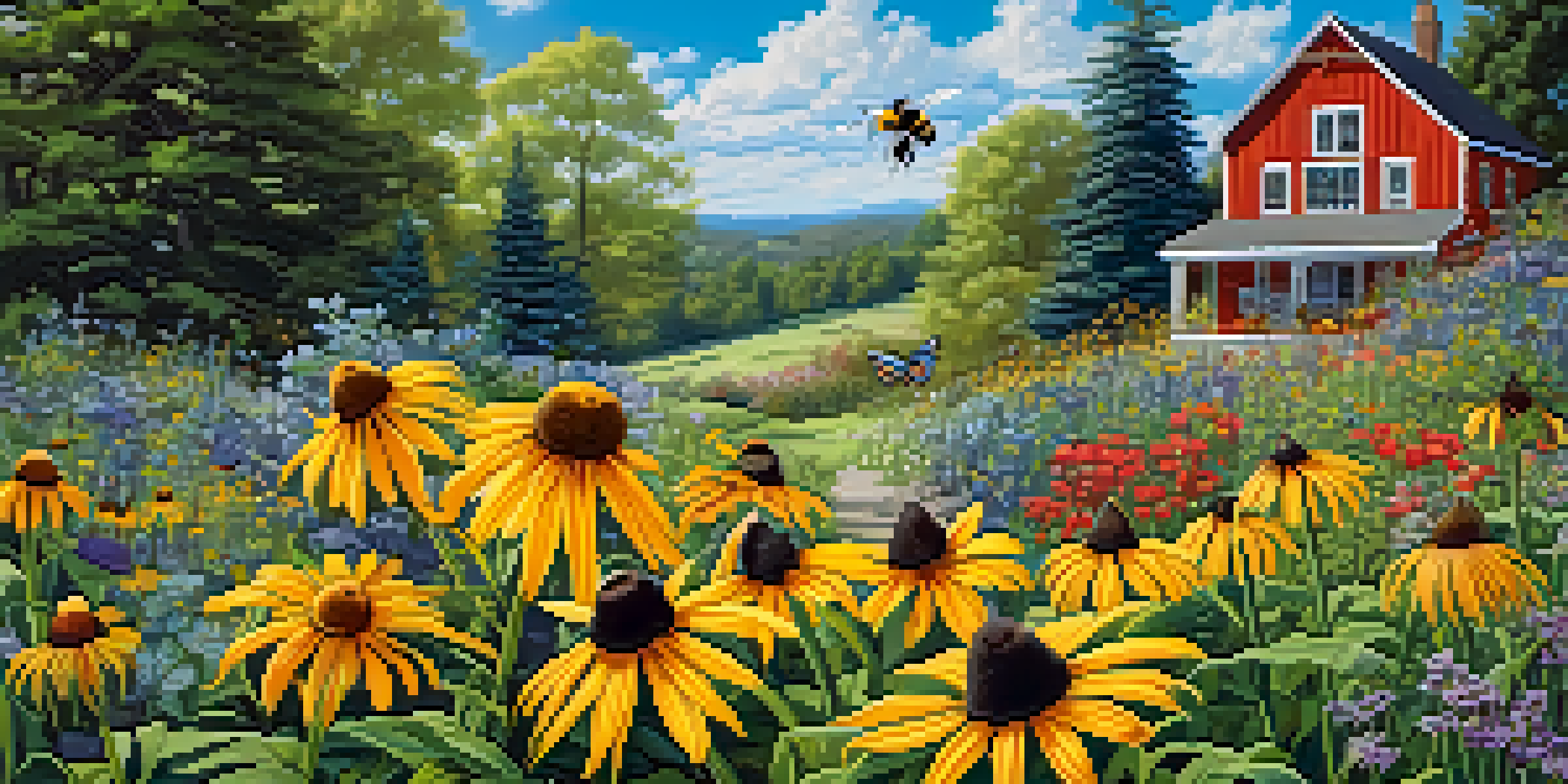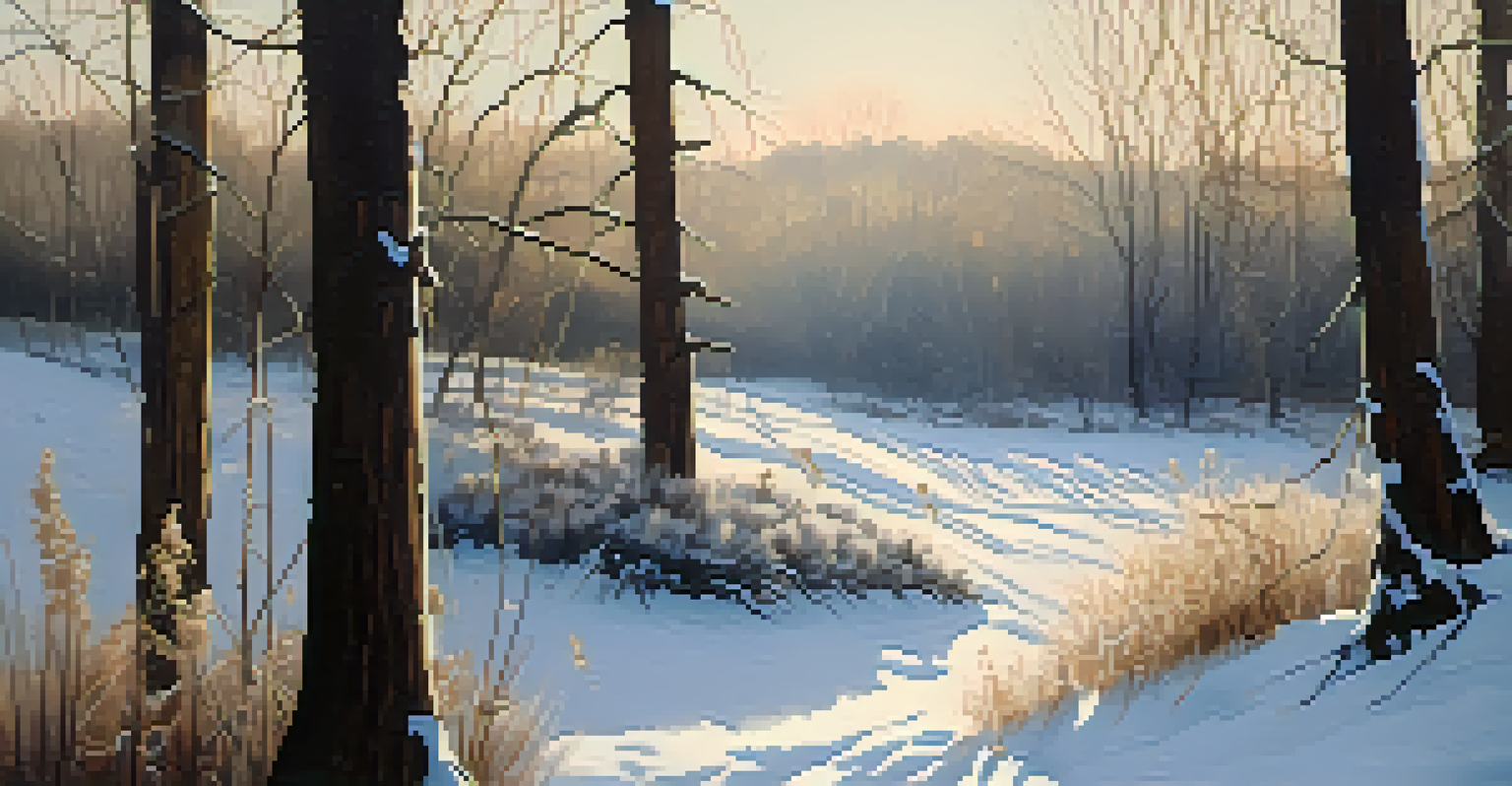Native Plants: Seasonal Guidelines for Low-Maintenance Gardens

Understanding Native Plants and Their Benefits
Native plants are species that naturally occur in a specific region, thriving in local conditions without needing much human intervention. They are adapted to the environment, which makes them resilient against pests and diseases. By incorporating native plants into your garden, you can create a low-maintenance oasis that supports local wildlife, such as bees and butterflies, enhancing biodiversity.
The best time to plant a tree was twenty years ago. The second best time is now.
One of the most significant advantages of native plants is their adaptability to climate and soil type, reducing the need for excessive watering and fertilizers. For instance, a native wildflower garden often requires less upkeep than a traditional garden filled with exotic species. This not only saves you time and effort but also conserves water, making it an eco-friendly choice.
Additionally, native plants can provide visual interest throughout the seasons. Many bloom at different times of the year, ensuring your garden remains vibrant and lively. This seasonal variety allows you to enjoy your outdoor space while supporting the natural ecosystem around you.
Spring: Preparing Your Native Garden
As winter melts away, spring is the perfect time to prepare your native garden for a new season of growth. Start by assessing your garden's soil and drainage, making any necessary amendments to create an ideal environment for your plants. Native plants often thrive in well-drained soils, so ensuring proper conditions can lead to a flourishing garden.

Once the soil is ready, consider planting a mix of perennials and annuals that bloom in spring. Species like coneflowers and black-eyed Susans not only provide beautiful blooms but also attract pollinators, which are vital for plant reproduction. Preparing your garden in the spring sets the stage for a lush, vibrant summer.
Benefits of Native Plants
Native plants thrive in local conditions, requiring less maintenance while supporting local wildlife and enhancing biodiversity.
Don't forget to mulch your garden after planting. Mulch helps retain moisture and suppress weeds, meaning less maintenance for you. A layer of organic mulch can also enrich the soil as it breaks down, providing nutrients to your native plants.
Summer: Maintaining Your Native Plants
Summer brings warmth and growth, but it can also present challenges like drought and pests. Fortunately, native plants are well-equipped to handle these conditions. Regularly check your garden for signs of stress, like wilting leaves, and ensure that your plants are receiving adequate water, especially during dry spells.
Nature does not hurry, yet everything is accomplished.
You can also embrace a 'hands-off' approach during summer. Native plants often have natural defenses against pests, meaning you won't need to use harsh chemicals to protect them. Observing your garden allows you to appreciate how these plants thrive with minimal intervention, reinforcing the idea of low-maintenance gardening.
Consider deadheading spent blooms to encourage more flowers and prolong blooming periods. This simple task can keep your garden looking fresh and vibrant without demanding too much of your time. Plus, it allows you to engage with your garden, making summer maintenance a pleasant experience.
Fall: Preparing for Dormancy and New Growth
As the vibrant colors of summer fade, fall is an excellent time to appreciate the beauty of your native plants while preparing them for dormancy. This season is perfect for planting new native species, as cooler temperatures help reduce transplant shock. Choose plants that will thrive in your local climate to ensure a successful start.
Another important task is to clean up any dead plant material. While many native plants can be left standing for winter interest and wildlife habitat, removing debris helps prevent disease and pests. A tidy garden also sets the stage for a fresh start come spring, allowing new growth to flourish.
Seasonal Garden Preparation
Each season presents unique opportunities to prepare and maintain your native garden, ensuring its health and vibrancy throughout the year.
Consider adding a layer of mulch in the fall to insulate the roots of your plants during the winter months. This protective layer helps regulate soil temperature and retains moisture, ensuring a healthy garden when spring arrives. Preparing your garden in fall can make a significant difference in its success the following year.
Winter: Embracing the Quiet Season
Winter is a time for rest and reflection in the garden, but that doesn't mean it's devoid of beauty. Native plants often provide structure and interest even in the colder months, with their seed heads and silhouettes creating a stunning winter landscape. Embrace this quiet period to appreciate the unique character your garden takes on during the chilly season.
While maintenance is minimal during winter, consider protecting sensitive plants from harsh conditions. Using burlap or evergreen boughs can provide shelter from wind and snow. This protective layer not only helps your plants survive the winter but also adds a rustic charm to your garden.
Winter is also an excellent time for planning future garden projects. Take stock of what worked and what didn't over the past year, and consider how you can enhance your native garden. Research new native species or design ideas that can elevate your garden when spring arrives, all while keeping low-maintenance principles in mind.
Incorporating Native Plants into Your Landscape
Integrating native plants into your landscape can transform your outdoor space into a thriving ecosystem. Start by assessing your existing garden layout and identifying areas where native plants can complement or replace non-native species. By making these changes, you can create a more harmonious environment that benefits both you and local wildlife.
Consider using native plants in various ways, such as borders, ground covers, or focal points. For example, a cluster of flowering natives can draw the eye and create a stunning visual display. Mixing heights and textures also adds dimension, making your landscape more inviting.
Importance in Local Ecosystems
Incorporating native plants into landscapes boosts local ecosystems by providing essential food and habitat for wildlife.
Don't be afraid to experiment with different combinations until you find the perfect fit for your space. Native plants can be just as versatile as traditional garden plants, offering unique colors and forms. The key is to embrace their natural beauty and let them shine in your landscape.
The Role of Native Plants in Local Ecosystems
Native plants play a crucial role in supporting local ecosystems by providing food and habitat for wildlife. Many birds, insects, and other animals rely on native plants for nourishment, making them essential for maintaining biodiversity. By choosing native species, you’re not just beautifying your garden; you’re contributing to the health of the environment.
Additionally, native plants are often more resilient to local pests and diseases, reducing the need for chemical interventions. This natural balance allows ecosystems to thrive while minimizing human impact. When you incorporate native plants, you help create a sustainable environment that benefits future generations.

Educating others about the importance of native plants can further amplify their impact. Consider sharing your gardening experiences with friends and neighbors, promoting the use of native species in their own landscapes. Together, we can foster a greater appreciation for our local flora and its vital role in preserving the ecosystem.
Resources for Choosing and Caring for Native Plants
Finding the right native plants for your garden can be made easier with the help of local resources. Many nurseries and garden centers now specialize in native species, offering a variety of options that are well-suited for your region. Additionally, local extension services often provide valuable information on the best native plants for your specific area.
Online resources, such as native plant societies and botanical gardens, can also guide you in selecting and caring for your plants. These organizations often offer detailed information about plant care, maintenance, and landscape design, making it easier to navigate your gardening journey. Don’t hesitate to reach out and ask questions; the gardening community is usually eager to help.
Finally, consider joining local gardening clubs or online forums where you can connect with fellow enthusiasts. Sharing experiences, tips, and even plant swaps can enhance your gardening knowledge and inspire you to create a beautiful native garden. With the right resources and support, your journey into low-maintenance gardening can be both enjoyable and rewarding.